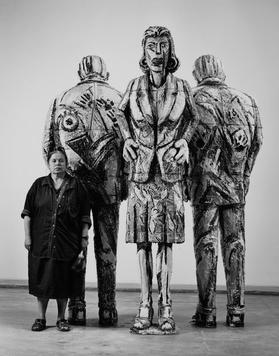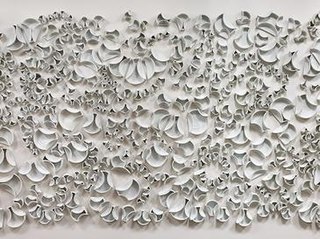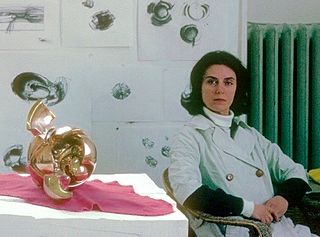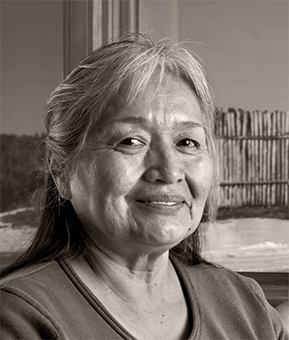
Nancy Graves was an American sculptor, painter, printmaker, and sometime filmmaker known for her focus on natural phenomena like camels or maps of the Moon. Her works are included in many public collections, including those of the National Gallery of Art, the Brooklyn Museum of Art, the Smithsonian American Art Museum, the National Gallery of Australia (Canberra), the Des Moines Art Center, Walker Art Center (Minneapolis), and the Museum of Fine Arts. When Graves was just 29, she was given a solo exhibition at the Whitney Museum of American Art. At the time she was the youngest artist, and fifth woman to achieve this honor.

Hannah Wilke (born Arlene Hannah Butter; was an American painter, sculptor, photographer, video artist and performance artist. Her work is known for exploring issues of feminism, sexuality and femininity.
Nora Naranjo Morse is a Native American artist and poet. She currently resides in Española, New Mexico just north of Santa Fe and is a member of the Santa Clara Pueblo, part of the Tewa people. Her work can be found in several museum collections including the Heard Museum in Phoenix, Arizona, the Minneapolis Institute of Art in Minnesota, and the National Museum of the American Indian in Washington, DC, where her hand-built sculpture piece, Always Becoming, was selected from more than 55 entries submitted by Native artists as the winner of an outdoor sculpture competition held in 2005. In 2014, she was honored with a NACF Artist Fellowship for Visual Arts and was selected to prepare temporal public art for the 5x5 Project by curator Lance Fung.
Amalia K. Amaki is an African-American artist, art historian, educator, film critic and curator who recently resided in Tuscaloosa, Alabama, where she was Professor of Modern and Contemporary Art at the University of Alabama at Tuscaloosa from 2007 to 2012.
Gloria June Tew was an American abstract sculptor known for her work in marble, bronze and steel. Tew's sculptures are found in institutions, museums, churches and private collections including, King Carl XVI Gustaf and Queen Silvia of Sweden. She resided in Minneapolis.

Viola Frey was an American artist working in sculpture, painting and drawing, and professor emerita at California College of the Arts. She lived and worked in the San Francisco Bay Area and was renowned for her larger-than-life, colorfully glazed clay sculptures of men and women, which expanded the traditional boundaries of ceramic sculpture.
Harriet Bart is a Minneapolis-based conceptual artist, known for her objects, installations, and artists books.
Beth Lo in Lafayette, Indiana is an American artist, ceramist and educator. Her parents emigrated from China.
Anita Fields is an Osage/Muscogee Native American ceramic and textile artist based in Oklahoma. She is an enrolled citizen of the Osage Nation.

Monica E. Rudquist is a ceramic artist working out of Minneapolis, Minnesota. She is known for her distinctive "spiraling shapes" and works primarily in porcelain. In addition, her work features wheel-thrown functional wares as well as large-scale, abstract wall installations.
JoAnn Verburg is an American photographer. Verburg is married to poet Jim Moore, who is frequently portrayed as reading the newspaper or napping in her photographs. She lives and works in St. Paul, Minnesota and Spoleto, Italy.
Dyani White Hawk is a contemporary artist and curator of Sicangu Lakota, German, and Welsh ancestry based out of Minnesota. From 2010 to 2015, White Hawk was a curator for the Minneapolis gallery All My Relations. As an artist, White Hawk's work aesthetic is characterized by a combination of modern abstract painting and traditional Lakota art. White Hawk's pieces reflect both her Western, American upbringing and her indigenous ancestors mediums and modes for creating visual art.
Jody Louise Williams was an American artist, writer, and teacher. She created and published artist's books under the imprint Flying Paper Press in her studio in Minneapolis, Minnesota. She worked in a range of media, including artist's books, collages, drawings, etchings, bronze sculptures, and mixed-media boxes that she calls not-empty boxes.

Luise Clayborn Kaish was an American artist known for her work in sculpture, painting, and collage. Throughout her career, Kaish's work was exhibited and collected by major museums, including the Smithsonian Institution's National Museum of American Art, the Museum of Modern Art, the Whitney Museum, the Jewish Museum, and the Metropolitan Museum of Art. Kaish created monumental sculptures in bronze, aluminum, and stainless steel, which remain on view in educational, religious, and commercial settings across the United States and internationally.

Françoise Grossen is a textile artist known for her braided and knotted rope sculptures. She lives and works in New York City. Grossen’s work has been acquired by the Metropolitan Museum of Art, New York; the Renwick Gallery, Smithsonian American Art Museum, Washington, DC; and the State Hermitage Museum, Saint Petersburg, Russia.
Meg Webster is an American artist from San Francisco working primarily in sculpture and installation art. While her works span multiple media, she is most well known for her artworks that feature natural elements. She is closely affiliated with Post-Minimalism and the Land Art movement and has been exhibiting her work since 1980.
Jantje Visscher is an American mixed-media artist and teacher. Her work involves painting, printmaking, photography, and sculpture. Visscher uses geometry and mathematics to explore the dynamics of perception and optical effects through the use of nontraditional mixed media. She lives and works in Minneapolis, Minnesota, and is active in the Women's Art Resources of Minnesota Mentor Program and the Traffic Zone Center for Visual Art. Visscher is best known for hard-edge abstraction and minimalism within her scientific approach and exploration of perception and mathematics.

Rose B. Simpson is a Tewa sculptor of Khaʼpʼoe Ówîngeh is a mixed-media artist who works in ceramic, metal, fashion, painting, music, performance, and installation. She lives and works in Santa Clara Pueblo, New Mexico. Her work has been exhibited at SITE Santa Fe ; the Heard Museum ; the Museum of Contemporary Native Art, Santa Fe (2010); the National Museum of the American Indian, Smithsonian (2008); the Denver Art Museum; Pomona College Museum of Art (2016); Ford Foundation Gallery (2019); The Wheelwright Museum of the American Indian (2017); the Minneapolis Institute of Art (2019); the Savannah College of Art and Design (2020); the Nevada Museum of Art (2021); Whitney Museum of American Art, and the Norton Museum of Art (2024).

Christine McHorse, also known as Christine Nofchissey McHorse, was a Navajo ceramic artist from Santa Fe, New Mexico.
Signe Margaret Stuart is an American artist best known for her abstract paintings and works on paper that are informed by Minimalism, quantum physics and the study of consciousness.








